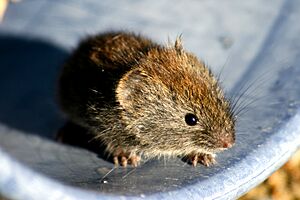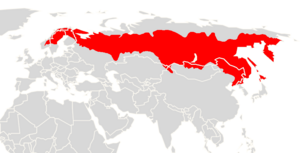Grey red-backed vole facts for kids
Quick facts for kids Grey red-backed vole |
|
|---|---|
 |
|
| Conservation status | |
| Scientific classification | |
| Genus: |
Craseomys
|
| Species: |
rufocanus
|
 |
|
| Range of Craseomys rufocanus | |
| Synonyms | |
|
|
The grey red-backed vole (also known as the grey-sided vole) is a small, furry animal. It belongs to a group of rodents called voles. An adult grey red-backed vole usually weighs between 20 and 50 grams. That's about the same as a few strawberries!
These voles live across a large part of northern Eurasia. You can find them in places like northern China, the northern Korean Peninsula, and the islands of Sakhalin and Hokkaidō in Japan. They are a bit bigger and have longer legs than the northern red-backed vole. They also sometimes live in the same areas as the Norwegian lemming.
What Does It Look Like?
The grey red-backed vole has a special look. Its back is a reddish color, and its sides are grey. This makes it easy to spot!
From its head to its body, it measures about 11 to 13 centimeters (4.5 to 5.25 inches) long. Its tail is shorter, usually about 2.5 to 4.5 centimeters (1 to 1.75 inches) long. You can tell it apart from other voles by its size and colors. For example, it's bigger than the bank vole. It also has longer legs and a longer tail compared to the northern red-backed vole.
Where Does It Live?
The grey red-backed vole lives in many parts of northern Europe and Asia. Its home stretches from Norway, Sweden, and Finland, all the way east through northern Russia. You can find it near the Kamchatka Peninsula, in the Ural Mountains, and the Altai Mountains. It also lives in northern Korea, Sakhalin Island, Japan, northern Mongolia, and China.
These voles can live from sea level up to high mountains. In Scandinavia, they are found up to 1,170 meters (3,840 feet) high. In Mongolia's Khangai Mountains, they can live as high as 2,700 meters (8,860 feet)! They like places with thick plants or rocky spots in forests. They often live near rivers in pine or birch forests. You might also see them in open forest areas, grassy fields, or even dry peat bogs.
What Do They Eat and How Do They Live?
The grey red-backed vole enjoys eating different plants. They munch on grasses and small herbs. They also eat leaves and shoots from small shrubs, and berries. They really like bilberry plants. However, they don't like the northern crowberry as much because it has a bitter taste.
Sometimes, in very cold, treeless areas called tundra, the number of these voles can grow a lot. Their population goes up and down in a cycle every four to five years. Scientists are still trying to fully understand why this happens. It might be linked to how many predators, like foxes or owls, are around. Lemmings also have similar population booms, but theirs are even bigger. Lemming numbers also go up and down in the same years as voles. This is partly because lemmings keep having babies even in winter, while grey red-backed vole numbers usually drop during the colder months.
Status
The IUCN (International Union for Conservation of Nature) has listed the grey red-backed vole as a species of "Least Concern". This is good news! It means they are a common animal and live in many places. They don't face any big threats right now. Even though their numbers go up and down in cycles, they are doing well overall. However, in some parts of northern Europe, their numbers might be going down a little. This could be because of changes in how forests are managed.


